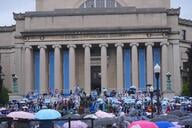You have /5 articles left.
Sign up for a free account or log in.

Istockphoto.com/yuoak
Over the past year, I have been reading and rereading the feminist manifestos of an Argentine feminist collective called Ni Una Menos (#NiUnaMenos). The collective is responsible for shedding light on the national and global system of abuses against women and transgender people. Beyond that, I also see how the collective’s approaches and actions might serve as an ethically useful model for faculty members like me. Indeed, I’ve thought a lot about how can we as professors can infuse our individual pedagogies with the activist agendas proposed by Ni Una Menos and similar organizations.
The #NiUnaMenos movement, and the wave of peaceful protests and performative activism that it is establishing, have opened my eyes to different ways of engaging diversity inside my classroom and around campus spaces. For instance, the work of women artists is often unappreciated and unsung. Maura Reilly, the founding curator for the Elizabeth A. Sackler Center for Feminist Art at the Brooklyn Museum, recalls that when the Modern Art Museum in New York City reopened in 2004, only a small fraction of the works were by women artists. The members of the Ni Una Menos movement, along with a group of around 200 women in the arts in Argentina, Nosotras Proponemos (We Propose), have taken steps to change that situation in Latin America: last March, at national art museums across Argentina and throughout the continent, they worked to literally shed light on female artists.
They accomplished that through many different means. In the National Museum of Fine Arts in Buenos Aires, they shut down the lights illuminating artworks created by men for one hour a day for about three weeks. In the Municipal Museum of Fine Art in Córdoba, the museum’s facade read, “We will propose to illuminate works of art by women.” And so on. Similar tactics occurred throughout the country, a process that Maura Reilly calls curatorial activism.
The idea of curatorial activism has made me ask myself what it would mean to revisit my own syllabi and courses as an activist. Oftentimes I have felt that my activist side has been swamped by the intense demands of academe, motherhood and simply my personal survival. As a human-rights scholar, I should make it a mission to put activism before anything, yet often the plethora of time commitments makes it so that activism is now my sidepiece -- something I’ll get to whenever I finally have time.
So I started slowly at first. I wanted to see how many works in my own syllabus were written by women, by writers of color, queer writers, women of color, transgender authors and others. I wanted to see if I, like the MOMA, was falling into a dangerous statistic. Was I privileging one voice over the others? Were my classes balanced?
The truthful answer is that they have not always been balanced. As I took inventory, I realized that I had neglected to teach a queer writer for an entire semester. How can I work on human rights and make that kind of dangerous omission? I immediately changed the syllabus and taught the course one more semester, making sure to include more queer voices. That enhanced not only the overall course material but also student participation in class.
Yet my curating did not finish with that course, and with that addition. It continued and continues -- a perpetual, never-ending, ongoing process of tinkering and curating.
Now, every time I think about drafting a new course or revising an old one, I put on my activist-curator hat and ask myself which voices I tend to represent and privilege and which ones, by neglect or ignorance, I leave out. When I was teaching at the University of California, Berkeley, one semester, a student gently and kindly made me aware of my own negligence in a class I taught on human rights and storytelling in the Americas. He simply asked me during office hours one day why I had not given enough attention to talking about accessibility and literary disabilities studies. “Is that,” he asked, “also part of human rights discourse?”
I felt mortified, and my own ignorance immediately dawned on me. How could I be so blind to open up the broad topic of human rights and not engage with those studies and authors? Instead of dwelling upon the omission, I told him that the course could benefit greatly from such explorations and guided him through some relevant sources for his final research project.
I know we faculty members cannot do it all. It is impossible to draft the perfect, all-encompassing, perfectly curated, leave-no-one-and-nothing-behind course. But, as I have learned, mindfulness goes a long way. Simply acknowledging forthrightly that certain histories get less attention in a particular class can make a big difference to the students. Students want, and often need, to see themselves reflected in their course materials. I wanted this so badly myself as both an immigrant and an undergraduate. I constantly read as much as possible about the immigrant experience within the United States in order to make sense of the cultural alienation I felt after my parents and I left Romania.
This semester, I am teaching a small course to freshmen at a liberal arts college in Maine. My transition from the West Coast to the East Coast has forced me to reassess some of the courses I taught previously while at a large public university. It has dawned on me that I must include Caribbean writers and scholarly studies within my syllabus. And not just brief overviews, but intense explorations of Caribbean history and identity, as many of the students taking Latin American studies courses (the kinds I teach) are from the Caribbean. I must begin curating my courses by investing time and energy into learning more about Caribbean history, literature and art. I must continue to curate my syllabus and my own mind.




